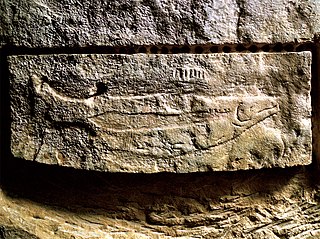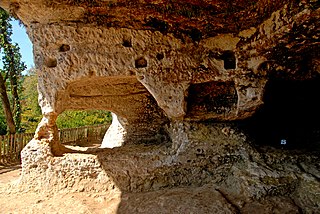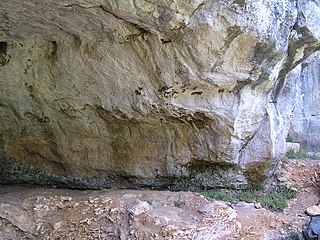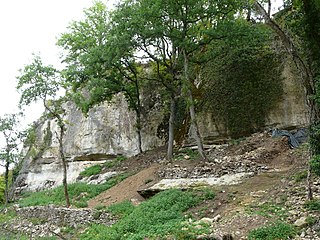
Lascaux is a network of caves near the village of Montignac, in the department of Dordogne in southwestern France. Over 600 parietal wall paintings cover the interior walls and ceilings of the cave. The paintings represent primarily large animals, typical local contemporary fauna that correspond with the fossil record of the Upper Paleolithic in the area. They are the combined effort of many generations. With continued debate, the age of the paintings is now usually estimated at around 17,000 years. Because of the outstanding prehistoric art in the cave, Lascaux was inducted into the UNESCO World Heritage List in 1979, as an element of the Prehistoric Sites and Decorated Caves of the Vézère Valley.

The Magdalenian cultures are later cultures of the Upper Paleolithic and Mesolithic in western Europe. They date from around 17,000 to 12,000 years ago. It is named after the type site of La Madeleine, a rock shelter located in the Vézère valley, commune of Tursac, in France's Dordogne department.

Cueva de La Pasiega, or Cave of La Pasiega, situated in the Spanish municipality of Puente Viesgo, is one of the most important monuments of Paleolithic art in Cantabria. It is included in the UNESCO World Heritage List since July 2008, as part of the inscription: Cave of Altamira and Paleolithic Cave Art of Northern Spain.

Gatecliff Rockshelter (26NY301) is a major archaeological site in the Great Basin area of the western United States that provides remarkable stratigraphy; it has been called the "deepest archaeological rock shelter in the Americas". Located in Mill Canyon of the Toquima Range in the Monitor Valley of central Nevada, Gatecliff Rockshelter has an elevation of 7,750 feet (2,360 m). David Hurst Thomas discovered Gatecliff Rockshelter in 1970 and began excavations in 1971. Full scale excavations occurred at Gatecliff Rockshelter for about seven field seasons in which nearly 33 feet (10 m) of sediments were exposed for a well-defined stratigraphic sequence. The well-preserved artifacts and undisturbed sediments at Gatecliff Rockshelter provides data and information have been applied to a range of research topics. Based on the analysis of the artifacts at Gatecliff Rockshelter, it can be determined that it was most likely a short-term field camp throughout prehistory. The latest evidence for human usage at Gatecliff occurs between ca. 5500 B.P. to 1250 B.P.

Roc-aux-Sorciers is an Upper Paleolithic rock shelter site dating to the mid-Magdalenian cultural stage, ca 14,000 yBP, made famous by its relief wall carvings. The site is in the French commune of Angles-sur-l'Anglin, in Vienne. The name 'Sorcerers' Rock', with its suggestions of pagan rendez-vous, was applied to the site long before the wall-carvings were discovered.

The Prehistoric Sites and Decorated Caves of the Vézère Valley is a UNESCO World Heritage Site in France since 1979. It specifically lists 15 prehistoric sites in the Vézère valley in the Dordogne department, mostly in and around Les Eyzies-de-Tayac-Sireuil, which has been called the "Capital of Prehistory". This valley is exceptionally rich in prehistoric sites, with more than 150 known sites including 25 decorated caves, and has played an essential role in the study of the Paleolithic era and its art. Three of the sites are the namesakes for prehistoric periods; the Micoquien, Mousterian, and Magdalenian. Furthermore, the Cro-Magnon rock shelter gave its name to the Cro-Magnon, the generic name for the European early modern humans. Many of the sites were discovered or first recognised as significant and scientifically explored by the archaeologists Henri Breuil and Denis Peyrony in the early twentieth century, while Lascaux, which has the most exceptional rock art of these, was discovered in 1940.

Qal'eh Bozi is a complex of caves sites located about 25 km (15.5 mi) south-southwest of Isfahan, Iran; northeast of Dizicheh and north of Hassanabad. The sites include two rock shelters and a cave located at altitudes between 1,750 and 1,810 m above sea level. The caves are found on the southern face of a limestone mountain of lower Cretaceous age that rises to more than 500 m (1,640.4 ft) above the plain floor. From the cave entrance there is a commanding view of the plain below and of the Zaiandeh Rud River flowing about 2 km (1.2 mi) to the south and southeast.

The archaeological site Abri de la Madeleine is a rock shelter under an overhanging cliff situated near Tursac, in the Dordogne département of the Aquitaine région of southwestern France. It represents the type site of the Magdalenian culture of the Upper Paleolithic. The shelter was also occupied during the Middle Ages. The medieval castle of Petit Marsac stands on the top of the cliff just above the shelter.

The Rouffignac cave, in the French commune of Rouffignac-Saint-Cernin-de-Reilhac in the Dordogne département, contains over 250 engravings and cave paintings dating back to the Upper Paleolithic. In conjunction with other caves and abris of the Vézère valley, the Rouffignac cave was classified a Monument historique in 1957 and a World Heritage Site in 1979 by UNESCO as part of the Prehistoric Sites and Decorated Caves of the Vézère Valley.

The Cantabrian caves' unique location make them an ideal place to observe the settlements of early humans thousands of years ago. The magnificent art in the caves includes figures of various animals of the time such as bison, horses, goats, deer, cattle, hands and other paintings. Archaeologists have found remains of animals such as bears, the remains of arrows and other material indicating a human presence; these artifacts are now found mostly in the Regional Museum of Prehistory and Archaeology of Cantabria.

La Chaire a Calvin is a rock shelter near the village of Mouthiers-sur-Boëme in the Département of Charente, situated in the valley of the Gersac stream. The shelter is on a cliff which faces south east. The rock face of this rock-shelter has a sculpted frieze dated to the Magdalenian period; approximately 15000 years BP.
The Kalemba Rockshelter is an archaeology site located in eastern Zambia, at coordinates 14°7 S and 32°3 E. Local tradition recalls the use of the rock shelter as a refuge during the time of Ngoni raiding in the 19th century. The site is known for various rock paintings as well as advanced microlithic use.

The caves of Arcy-sur-Cure are a series of caves located on the commune of Arcy-sur-Cure, Burgundy, France. Some of them contained archaeological artefacts, from the Mousterian to Gallo-Roman times.

The Pair-non-Pair Cave is located near the village of Prignac-et-Marcamps, Aquitaine:Gironde (33) department in France. Only discovered in 1881 it is known for remarkable prehistoric parietal engravings - petroglyphic representations of wild animals, "which rank among the most ancient examples of art made by prehistoric" humans, dating back to between 30,000 and 25,000 BP, the Aurignacian cultural period of the Upper Paleolithic.

The abri de Cap Blanc is a prehistoric limestone rock shelter with Magdalenian animal sculptures. It is in the Marquay commune on the right bank of the Beune River, a few kilometers west of Eyzies-de-Tayac, in Dordogne.

Le Regourdou is an archaeological site in the Dordogne department, France, on top of a hill just 800 m (2,600 ft) from the famous cave complex of Lascaux. At this now collapsed 35 m (115 ft) deep ancient karst cavity remarkably well preserved Neanderthal fossils were recovered, that might be skeletal remains of deliberate burials. According to the current excavation team at the site, the correct name of the location is "Regourdou". "Le Régourdou" is considered a misnomer and should be avoided.

The Cave of Aurignac is an archaeological site in the commune of Aurignac, Haute-Garonne department in southwestern France. Sediment excavation and artefact documentation since 1860 confirm the idea of the arrival and permanent presence of European early modern humans during the Upper Palaeolithic. The eponymous location represents the type site of the Aurignacian, the earliest known culture attributed to modern humans in western Eurasia. Assemblages of Aurignacian tool making tradition can be found in the cultural sediments of numerous sites from around 45,000 years BP to around 26,000 years BP. In recognition of its significance for various scientific fields and the 19th-century pioneering work of Édouard Lartet the Cave of Aurignac was officially declared a national Historic Monument of France by order of May 26, 1921.

Castel Merle is a complex of 10 prehistoric rock shelters in Sergeac, in the Dordogne region of France. It is close to the Lascaux rock art caves and is situated in the region which forms the Unesco World Heritage site Prehistoric Sites and Decorated Caves of the Vézère Valley, but is not officially a part of it. The finds in the shelters date to the Mousterian and Magdalenian periods, or between 160,000 and 12,000 years ago. The most important of the 10 shelters is the Reverdit rockshelter.

Château Cramirat is a 12th-century Templar castle in the village of Sergeac, Dordogne (Nouvelle-Aquitaine), southwest France. A French national historic monument, the château is situated in the heart of the Vézère river valley, a UNESCO World Heritage Site known as the Valley of Mankind.

The National Museum of Prehistory is a French institution founded in 1918 by Denis Peyrony in the commune of Les Eyzies-de-Tayac, in the Dordogne. Officially inaugurated on September 30, 1923, it is housed in what was formerly the Château de Tayac, purchased for this purpose by the State in 1913. In 2004, a new museum, designed by Jean-Pierre Buffi, was inaugurated on the emblematic cliff face of Les Eyzies.





















